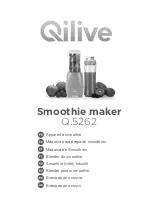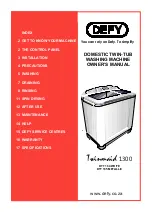
EN
17
make sure that the gas tap is closed.
It is recommended to seal the connections with a
•
Teflon tape.
7.1 Connecting to the natural gas supply sys-
tem
The cooker may be connected to the gas supply
•
system using a rigid pipe or a flexible metal hose
conforming to the requirements of national stan
-
dards
The maximum length of the flexible hose must not
•
exceed 2.0 m. The hose must not come into con
-
tact with any moving parts. Sufficient space must
be provided for the hose
When connecting to a rigid pipe, care must be ta
-
•
ken to avoid exposing any part of the device or
point of gas installation to excessive mechanical
stress.
7.2 Connecting to an LPG cylinder
If you wish to use an LPG cylinder, do not install
•
the cooker in the basement or in any other room
where the floor is below the ground level, as LPG
is heavier than air and accumulates at the floor le
-
vel.
When connecting the appliance to an LPG cylinder,
•
use a rubber hose conforming to the requirements
of national standards
To connect the cooker with a rubber hose, use
•
a steel pipe with the length not less than 0.5 m
(7.2.1).
The length of the rubber hose should not exceed
•
1.5 m (7.2.1). Upon connecting, the hose should
be secured with hose clamps at each end.
The hose must not be choked, twisted or bent shar
-
•
ply and must be accessible along its entire length.
The hose must not laid near any sources of exces
-
•
sive heat (max. 50°C)
Broken hose must be immediately replaced. Any
•
repairs to a leaky hose are strictly forbidden.
Every time you connect the cooker to the LPG cy
-
•
linder, check the air tightness at the cylinder valve
and at the connection of the regulator to the cylin
-
der, and its operation.
WARNING!
1. Under no circumstances can the air tightness
be checked by means of a naked flame (e.g.
with a match or candle). Danger of explosion!
Use soapy water to check the air tightness.
2. The condition of the hose and the tightness of
the connection should be checked periodically
in accordance with the applicable regulations.
3. Rubbed hose must not come into contact with
any hot elements of the cooker.
7.3 Replacing the nozzles
If it is required to change the type of gas supplied
to the cooker, it is necessary to replace the nozzles
and fill in the “Gas Conversion” sticker supplied with
the appliance in a plastic seal containing the warran
-
ty card and the instruction manual. Upon specifying
what type of gas the appliance was converted to, put
the sticker on the appliance.
Replacing the nozzles
shut off the valve cutting off the cooker from the
–
gas supply system or from the cylinder,
turn off all gas taps in the cooker,
–
remove pan supports, lids and rings from burners
–
on the gas hob,
remove the nozzles and replace then according to
–
Table 1,
put hob burners’ lids and rings back into place,
–
adjust gas taps on the gas hob,
–
check the connections for soundness.
–
7.4 Adjusting the gas taps
The adjustment of hob burner taps is accomplished
by setting the flame on the burner in the simmering
position.
Adjusting the taps:
open the gas flow with the knob and light the bur
-
–
ner to be adjusted,
2E-G20 20mbar
2E-G20 13mbar
3B/P-G30 30mbar
Small
burner
X072
084
050
Medium burner
Z097
110
065
Large burner
Y118
145
085
Arrangement of
burner nozzles
Table 1 Burner nozzle specification
Summary of Contents for TG 5201ZSB
Page 1: ...PL RU EN INSTRUKCJA MONTA U I U YTKOWANIA INSTRUCTION MANUAL TG 5201ZSB O...
Page 2: ...1 6 4 1 7 4 1 1 1 1 7 2 1...
Page 3: ...2 9 2 1 8 1 1 8 2 1 8 2 2 8 2 3 8 2 4 8 3 1 8 6 1 8 7 1 8 7 2...
Page 10: ...RU 9 90 396 GAD 1 1 1 2 1 2 2 1 0 1 75 3 0 2 3 1 1 1 1 2 3 4 5 6 7 1 2 3 4 8 5 6 7 8 9 10 11...
Page 11: ...RU 10 6 1 6 2 6 3 6 4 600C 6 5...
Page 12: ...RU 11 6 6 650 6 4 1 6 7 G1 2 7 1 2 0 7 2 0 5 7 2 1 1 5 7 2 1 50 1 2 3 7 3 1...
Page 15: ...RU 14...
Page 22: ...EN 21...
Page 23: ...EN 22...







































